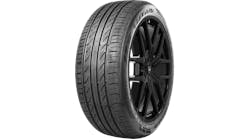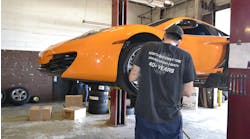Ultra-high performance (UHP) tires are available for a variety of driving conditions. Taking the time to make sure your customer selects the correct version will provide him or her with the ideal tire.
No single tire model is capable of providing maximum performance under all circumstances. Tire designs and materials can be formulated to provide maximum tread life, maximum dry traction, maximum wet traction, maximum ride comfort or maximum traction in snow and ice, depending on the desired performance target.
UHP tires, are available in two basic categories: summer and all-season. In terms of winter tires, high performance winter tires are available that, while commonly not labeled as ultra-high performance, are very close to UHP in terms of performance levels (but obviously focused on winter use).
1. Summer UHP tires generally feature directional or asymmetric designs, and their construction and materials tend to focus primarily on dry and wet handling and traction. This focus will involve stiffer sidewalls (achieved in part by low profile designs) in addition to bolstered construction and relatively softer tread compounds that provide increased traction.
2. All-season M+S UHP tires are directed more at “everyday” use. Without giving up dry and wet handling, these tires are designed to also offer good traction on snow and ice.
This category of UHP tires encompasses a very wide range of tire models.
[PAGEBREAK]
As far as internal construction is concerned, UHP summer and UHP all-season tires are very similar in nature. The all-season performance attributes are primarily achieved in terms of tread design and compounding.
Due to design, construction and materials among the various manufacturers’ lines of all-season UHP tires, tire dealers must understand the differences among their brands’ offerings within the UHP all-season range, in order to provide the best choice for the specific customer and his/her needs.
Winter performance tires are, as the term implies, focused more closely on providing maximum snow and ice performance. High performance winter tires (designs that make them fall into the “UHP” area) may feature additional sidewall stiffening reinforcements that provide superior steering response and handling, in order to compensate for the softer compound. “Conventional” winter tires generally feature more flexible sidewalls at the expense of crisp response, while high-performance winter tires may offer more robust reinforcement to provide more of a UHP steering response/handling characteristic.
Naturally, UHP winter tires also feature tread designs and compounds that are specifically tuned for low temperature and snow/ice conditions.
Examples of UHP
While we don’t have the space here to list every make or model of UHP tires, following are but a few examples of UHP tires. Noting their design and construction will help you better understand how UHP tires work from both technical and aesthetic standpoints.
1. Bridgestone Potenza RE750. The UHP summer tire was developed for the drivers of sports cars and sporty coupes to provide traction on dry and wet roads. It uses Bridgestone Corp.’s UNI-T network of technologies to improve three primary factors of the tire’s performance: the bead, casing and tread compound.
Like all summer tires, the RE750 is not intended to be driven in near-freezing temperatures, through snow or ice.
The Potenza RE750, inspired by the Bridgestone Potenza racing tire, uses an ultra-high performance tread compound to enhance dry traction, while its directional tread pattern enhances wet traction. Together, the tread design and compound help to sweep water away from between the tire’s contact patch and the road to improve wet grip and reduce the possibility of hydroplaning.
This tire has been engineered to reduce road noise, especially when worn, by combining interconnected shoulder blocks with continuous circumferential ribs in the center of the tread design to help reduce the possibility of heel/toe and alternate block wear. Internally, the casing and twin steel belts deliver responsive handling and cornering stability. The steel belts are reinforced with spirally wound nylon to provide high speed durability, while minimizing weight and maximizing ride qualities.
The Potenza RE750 also features Rim Guard (rubber ridges on the lower sidewalls) to function as bumpers to help protect wheel rims from curb damage.
[PAGEBREAK]
2. Pirelli P Zero Nero. This M+S UHP all-season tire was designed specifically for the North American market to provide year-round traction and handling for cars with “sporty dispositions.” The P Zero Nero M+S is built using the MIRS (Modular Integrated Robotized System) technology manufacturing process, Pirelli Tyre SpA’s most advanced tire design and production system.
The P Zero Nero M+S is the maker’s UHP choice for drivers who want to drive their cars through America’s various weather conditions, including occasional light snow.
The tire features a silica-enhanced tread compound blended to provide traction during high temperatures in the dry and low temperatures in the wet or light snow. This compound is molded into an asymmetric tread design that features stable outside shoulder blocks combined with notched, continuous center ribs that increase footprint rigidity to enhance grip during acceleration and braking.
3. Kumho Ecsta SPT XRP. This is Kumho Tire U.S.A. Inc.’s UHP summer self-supporting (run-flat) tire, which was developed to provide temporary, continuing mobility (up to 50 miles at up to 50 mph) in the event of a puncture causing air loss for sports cars, coupes and sedans. The Ecsta SPT XRP is designed to offer grip, handling, comfort, wear and a visual statement that appeals to enthusiastic drivers.
The tire is not intended to be driven in near-freezing temperatures, through snow or ice.
Ecsta SPT XRP tires feature Kumho’s High Dispersion Silica tread compound, which broadens the tread rubber’s temperature operating range, molded into a directional tread design. The design features large, independent shoulder blocks; four straight, circumferential grooves; and three solid center ribs that are engineered to combine wet grip and responsive handling with high speed stability.
Rotation wear indicators are built into the tire to let drivers know when it’s time to rotate the tires in order to maintain even wear and lower noise levels as the tire approaches the later stages of its tread life. The Ecsta SPT XRP tire’s structure includes twin steel belts reinforced by a spiral-wrapped, jointless, nylon cap ply to enhance ride quality while providing high speed durability. Rubber run-flat inserts are molded on the inside of both sidewalls to provide temporary sidewall support in the event of an inflation loss.
[PAGEBREAK]
4. Cooper Zeon Sport A/S versus Zeon 2XS. The Sport A/S UHP all-season tire features a coupled silica tread compound for excellent wet traction, and a directional tread design with a continuous center rib that increases footprint rigidity and steering response while allowing rapid water expulsion to reduce hydroplaning. Other features include a stylish black sidewall for an aesthetically pleasing design in tune with today’s modern vehicle requirements, a variable pitch tread block sequence for noise reduction and ride comfort, and a “W” speed rating.
The Zeon 2XS, Cooper’s summer UHP tire, features a racing-inspired tread compound that was benchmarked against the company’s Avon race division technology. The Zeon 2XS tread compound contains a homogenous tire filler system that includes chemically coupled precipitated silica and carbon black. The silica allows superior wet traction without sacrificing tread wear.
The shoulder tread block is divided into two harmonically mated segments. The calculated stagger of the tread element reduces noise frequency. A rubber rim protector extends beyond the rim flange and decreases the chance of rim damage that can occur if a tire/wheel scuffs a curve.
A spiral wound nylon overwrap combats centrifugal force under high speed conditions. This ability inhibits tire growth and maintains stability and carcass integrity across the entire speed range of the tire.
The hardened rubber compound, or bead filler, above the bead discourages sidewall flexing during cornering, which enhances handling. The slightly rounded mold profile of the Zeon 2XS balances wet traction and long tread life.
5. Federal Formoza FD2. This tire represents the next step in the evolution of Federal’s FD1. Technical features include variable sub-grooves, a wider solid central rib for greater straight line stability, wide circumferential grooves and tread pattern to prevent hydroplaning, and computer-designed tread elements engineered to provide a stable footprint and long, even tread wear. It also is engineered using Federal Corp.’s DPET (Disorder Pitch Evolution Theory) noise reduction technology.
6. Hero Milanza HZ1. This offering, also from Federal, is the latest generation UHP tire in the Hero line. Based on race tire technology, its aggressive, V-shaped tread and silica compound enhance steering stability, resistance to hydroplaning and braking/cornering control under extreme conditions.
Other components include a “Three Radius Tread Arc” for even pressure across the contact patch; steel sidewall and belts; Federal’s “Opti-Noise Technology” to ensure a quiet ride; and flange protectors.
7. Continental ContiSportContact 3 vs. General Exclaim UHP. Both are ultra-high performance tires, but they rely on different tread patterns for different performance characteristics. The ContiSportContact 3 has asymmetric tread ribs with exceptional longitudinal stiffness for ultimate dry handling. Four postcard-size contact patches help improve the tire’s stability.
The Exclaim UHP has a V-shaped, directional tread pattern for efficient water evacuation. The tread area also contains a solid, overlapping center with elements that allow for steering precision, dry traction and cornering stability.
[PAGEBREAK]
8. Lexani N3000. The bead of the Lexani N3000 is made using brass-plated, high tensile steel wire. It is constructed in a continuous, seamless single wire before being coated with rubber to create the raw bead ring. The result is an extra-strong bead, according to the tire’s distributor, ZT Wholesale, a division of Sentaida International. “This is important for a UHP tire since the bead is the critical contact point with the wheel and must withstand the high stress of acceleration, braking and cornering without separating from the wheel. The stronger bead also aides in resistance to impact damage.”
The N3000’s tread features a proprietary silica-based compound designed to reduce rolling resistance and improve wet traction by replacing the amount of carbon black used in the tread. (Nexen Tire Corp. manufactures the tire for ZT Wholesale.)
Winter performance
When selecting UHP tires specifically for winter use, you don’t necessarily need to stick with the original or same size summer tire for the vehicle. If the customer’s vehicle was originally equipped with low-profile, wide performance tires, it’s suggested that you deviate from that tire size in order to maximize winter traction.
A wide tire will tend to float over or plow through snow, while a narrower tire will have more of a chance to dig or slice into the snow. This requires moving to a tire that features a narrower section width, while maintaining close to the original tire’s overall diameter. Moving to a higher profile (taller sidewall) is part of this equation, since a tall sidewall will flex more than a low sidewall, and this flexibility aids in achieving snow traction.
Changing from a short sidewall and wide section width to a taller profile and narrower section width can be termed “minus sizing.” One example of this minus-sizing approach would involve a vehicle that was initially equipped with summer tires in size 225/45HR17. For a dedicated winter tire application, a winter tire size could involve a 195/65R15. This change, in replacing 17-inch wheels with 15-inch wheels while selecting a tire that maintains close to the original outer diameter, would represent a “Minus-Two” change. While this might fly in the face of a performance-minded customer who may initially be annoyed at the prospect of losing his or her “performance” appearance, this change would, in fact, improve the vehicle’s performance in winter conditions.
Winter tires tend to feature softer compounds — one of the factors that aids in snow/ice grip. This makes winter tires more susceptible to premature wear in terms of alignment angles and inflation pressures.
While it’s important to maintain any vehicle’s wheel alignment angles for proper handling and directional control, and to extend tire life, this issue is compounded by the softer compounds of winter tires, which will naturally wear faster if wheel alignment and/or tire inflation is incorrect.
[PAGEBREAK]
MATCHING THE CUSTOMER TO THE TIRE
Driving conditions and style will affect the buy. So will value
When trying to select the appropriate ultra-high performance, or UHP, tire (summer, all-season or winter) for a customer, the rule of thumb is to select the type of tire that will accommodate the worst driving conditions that the customer expects. Here are a few examples.
Example 1. A customer lives in a climate that never experiences snow and ice. His vehicle won’t be used to make trips to cold climates during the winter months. It also is a pleasure vehicle that isn’t necessarily used for daily commuting 365 days per year.
In this situation, summer UHP tires would be the best choice because they provide optimum handling and traction primarily on dry and wet roads.
Example 2. The vehicle is used on a daily basis, and the driver expects to experience a range of road conditions that include primarily dry and wet roads, with additional exposure to snow and ice conditions during brief winter periods. In this case, an all-season UHP would be the best choice.
If the customer expects optimum performance, he or she needs to consider the road conditions and driving habits under which the tires will be expected to perform at their best. It’s not uncommon for consumers to assume great wet weather grip equates to great snow/ice grip.
Just because a high performance tire is designed for outstanding wet weather traction does not mean that the same tire will provide high grip in colder temperatures on snow or ice.
If a customer is willing to dedicate one set of wheels and tires for non-winter use and another set of wheels and tires specifically for winter conditions, he or she will experience the best of both worlds.
Driving style also must be taken into consideration. For instance, if the vehicle frequently is exposed to long trips on smooth highways, a tire that provides a smooth and quiet ride, coupled with long tread life, would be the best choice.
However, if the driver routinely experiences congested traffic conditions, a more responsive (lower profile) tire may be better suited to his needs. And if the driver enjoys driving on challenging/twisting roads, a more responsive (lower profile/wider section width) tire would be the ideal.
[PAGEBREAK]
Finally, the subject of price vs. value should be included in any discussion on matching the tire to the customer. To illustrate this, we quote The Tire Rack:
“Why is it that the price of fuel for our vehicle seems relatively inexpensive while the cost of its tires seems high? If we keep track of our total costs, we will find that typical total fuel costs for 10,000 to 20,000 miles of driving actually exceeds our tire costs.”
Considering the value obtained over the life of the tires can easily convince many customers to spend more now for their premium choice of tires, once they understand the value to be enjoyed.
HANDBOOK Q&A: How do fillers affect rolling resistance?
The fillers used in compound creation involve various types of carbon black and/or silicas. The filler’s job is to provide reinforcement for the elastomers from a dynamic standpoint. To use an engineering term, the filler helps to provide the “hysteresis level” of the tread.
Hysteresis is the measure of the tread’s energy absorption. A “high hysteretic” compound indicates that the tread absorbs more energy (in simple terms, it is easier to deform). The result is an increase in rolling resistance... it takes more energy to roll down the road.
A “low hysteric” compound is more resilient, absorbs less dynamic energy, and is, therefore, lower in rolling resistance. The result is that the vehicle exerts less energy, which translates into more effective use of the engine’s power and, at least in theory, reduced fuel consumption.




